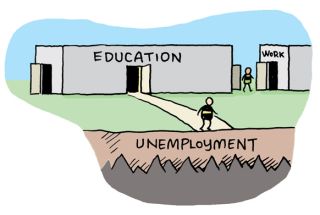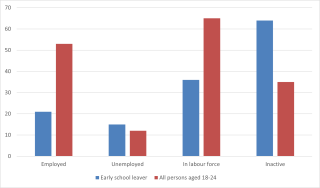Impact of education levels on employment outcomes

Access to appropriate education and skills development from early years to adulthood is one of the key public services that enables participation in society, public life and the labour market. Educational attainment is one of the key determinants of labour market outcomes for an individual. Education not only benefits the individual, but society as a whole gains. The potential impact of digital transition on the labour market makes access to education and training throughout adulthood a priority.
The Educational Attainment Thematic Report Quarter 2 2021 from the CSO gives us an overview of how Ireland fares in terms of educational attainment.
- More than half (53%) of 25-64-year olds in 2021 have a third level education. Younger age groups reported the highest levels of third level attainment with 61% of 25-34-year olds having a third level qualification.
- Employment rates for those aged 25-64 years old increase as the level of education attained increased
- Just under two-thirds (64%) of early school leavers aged 18-24 were not economically active in compared to 35% of other persons aged 18-24.
- In Dublin, 61% of those aged between 25-64 had a third level qualification in comparison to 44% in the Border and Midlands areas.
- Females aged 25-64-years old with a third level qualification were more than three times as likely to be employed (81%) compared to females with a primary education or no formal education (24%)
- Around 4% of people aged between 25-64 had only a primary school education or no formal education.
Tertiary Education
Ireland is doing very well in terms of third-level education. Ireland had the fourth highest third level educational attainment level in the EU-27 in 2020 at 58%, behind Luxembourg (62%), Cyprus (60%) and Lithuania (60%). The EU-27 average is 41%.
Younger age groups reported the highest levels of third level attainment, with more than half of the 25-34 and 35-45-year olds in this category (61% and 59% respectively), compared to approximately one-third (34%) of 60-64-year olds. This reflects increased levels of participation in third level education over time.
People with a third-level qualification are also more likely to be employed. This is most notable for persons aged 25-64 years with a third level qualification - this cohort have an employment rate of 85%, compared to persons age 25-64 years with no formal education/primary education having an employment rate of just 32% in Q2 2021. . In Q2 2021, females aged 25-64 with a third level qualification were more than three times as likely to be employed (81%) compared to females with a primary education or no formal education (24%). On the other hand, males aged 25-64 with a third level qualification had an employment rate of 90% compared to 38% of those with a primary education or no formal education.
Conversely, those with no formal education/primary education had an unemployment rate of 11%, compared to those holding a third level qualification with an unemployment rate of 4%. The proportion of those aged 25-64 years old with a third level qualification was 53% in Q2 2021, while 4% reported that they had primary education/no formal education only
In Q2 2021, males aged 25-64 years old with a primary education or below were more than twice as likely to be unemployed (10%) compared to males with a third level qualification (4%). The corresponding values for females in Q2 2021 were 12% and 4% respectively.
Early School Leavers
An Early school leaver is a person aged 18-24 whose highest level of educational attainment is lower secondary or below and are not currently in education. Ireland has performed well on reducing the rate of early-school leaving since 2005 and had the fourth lowest rate in the EU-27 in 2020.
In Q2 2021, only 3% of those aged 18-24 were defined as early school leavers, a decrease from 12% in Q2 2005. In Q2 2021, females aged 18-24 years old were less likely than males to be classified as early school leavers (2% versus 4% respectively). Despite the progress made on early school leaving, the long-term impacts of early school leaving on individuals both socially and economically remains a cause of concern. A previous report by the CSO (2019) analysed the outcomes for students who started second level education in 2011 – 2013. When comparing early school leavers to those who completed the Leaving Certificate, the report found that just 43.8 per cent of early school leavers were in employment compared to 74 per cent of their peers who finished school, and that the median earnings for early school leavers were €65 less than their peers (€345 per week compared to €410 per week).
Early school leavers have poor labour market outcomes. Just under two thirds (64%) of early school leavers aged 18-24 were not economically active compared to 35% of other persons aged 18-24 in Q2 2021. Early school leavers had an employment rate of just 21% in Q2 2021, much lower than other persons aged 18-24 (54%). The unemployment rate for early school leavers was 15% compared to 12% for other persons aged 18-24.
Chart 1: Labour market status of Early school leavers Q2 2021

Source: CSO Educational Attainment Q2 2021
The poor labour market status of early school leavers points to the need for a continued focus on this cohort and on addressing educational disadvantage. As we move towards a future where digital transformation will disrupt the labour market, having the greatest impact on people with lower levels of education and skills it is important that this cohort are not left behind.
Regional
The CSO report also found regional differences in educational attainment rates, with 6% of people in the Border area and 3% of people living in the West, South-West and Dublin attaining primary only or no formal education. For secondary education 24% of people living in Dublin and 35% of people in the Midlands attained a secondary education. Around 61% of people in Dublin attained a third level education while 44% of people in the Border and Midland regions attained a third level education.
Make lifelong learning and skills development a priority
Accessible and high quality education and training across the life cycle will support people to become active and engaged citizens, and equip them with the necessary critical and creative skills to navigate an ever-changing employment environment. While the latest CSO Educational Attainment Report shows that Ireland is making progress, concerns remain regarding early school leaving and the poor labour market outcomes for people with low or no formal educational qualifications.
Participation in high quality education has benefits not only for young people themselves but also for taxpayers and society. These benefits typically last over the course of an individual’s lifetime. According to the OECD adults with a tertiary degree in Ireland earn on average 81 per cent more than adults with upper secondary education. They are more likely to be employed, the employment rate is 11 percentage points higher for degree holders than for those with an upper secondary or post-secondary non-tertiary education (OECD, 2019). Socio-economic disadvantage also follows a student throughout the education system with younger graduates from more affluent areas earning around €2,000 more a year on average than their peers from disadvantaged areas. Even when controlling for different factors, graduates from disadvantaged backgrounds earn more than €600 less after graduation than others (HEA, 2020:129). This presents a challenge to policymakers, and points to the value of investing in education at all stages, and the particular importance of investing in early childhood education, and a continued focus on tackling educational disadvantage. The benefits of investing in education, both to the individual, to the economy and to society, far outweigh any initial outlay of resources. This is something that should be at the forefront of decisions regarding the investment and resourcing of our education system as a whole.
References
Central Statistics Office (2019b Post-Primary Outcomes - Academic Years Ending 2012 & 2013.
Higher Education Authority (2020) Graduate Survey Outcomes Class of 2018. Dublin: HEA
OECD (2019) “Ireland”, in Education at a Glance 2019: OECD Indicators, Paris: OECD Publishing.